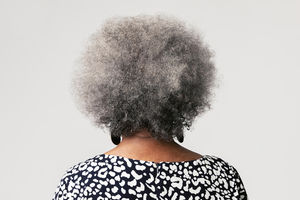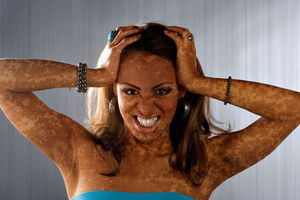
Tracy Muasa during an interview on February 7 at Nation Centre in Nairobi. She has been living with vitiligo since 2011.
Tracy Muasa’s face glows. That is the first thing you notice when you meet her. It may have been obvious had she not been suffering from vitiligo, an incurable skin condition that causes loss of colour, leading to someone having patches.
For the 39-year-old, she has to abide by a daily beauty routine before she leaves her house, which includes applying layers and layers of foundation, evened out by several dusts of compact powder and to sum it all up, bright lipstick.
To some perhaps, this is just any other beauty routine, but for this mother of two, for her skin to look this good, it is hard work and a way to boost her self-esteem.
Tracy has been doing this since 2016 to hide patches of pale skin below her nose and around her lips.
In November 2011, she was diagnosed with vitiligo, a condition that has spread to parts of her face, arms and feet, where the pale patches of white skin are visible.
“At first the patches of pale skin weren’t so visible, and so I didn’t see the need to apply makeup, but by 2016, they became more pronounced and spread to other parts of my face,” she says.
She resolved to cover the patches with makeup when people started staring at her.
“I started getting stares and this made me uncomfortable. I began wearing makeup to conceal the marks,” she says.

Vitiligo is a disorder where white patches occur on the skin due to destruction of melanocytes. PHOTO | FOTOSEARCH
Tracy’s condition began as white spots on the tips of the nails, feet and lower lip. This was some three months after she had joined the pharma industry, and at some point, she says, she was afraid that perhaps her new job was a trigger.
“I do quality assurance documentation in the validation section, and even though this is completely separate from the production block which involves the manufacturing of drugs, there was some sense of fear of whether there were some relations,” she says.
It is the same fear that her late mother had, and she asked Tracy to resign from her pharma job. She did not quit her job, but it aroused her curiosity about the condition, as she sank online in search of answers.
“The moment I realised it was vitiligo, Google became my friend and that is when I learnt that vitiligo sometimes runs in families. I did some research in our family tree and found out that two of my distant relatives had it too,” she says.
She visited a dermatologist where she was put on a treatment regimen.
“I was given melanocyl tablets for pigmentation, levamisole tablets for controlling disease progression, as well as other supplements like vitamin D3. I was also prescribed topical steroid ointment to apply on the affected areas, to stop the spread of the white patches.”
Though vitiligo does not cause direct physical impairment, there is a stigma attached to this condition because it is cosmetically disfiguring, and experts say, this leads to serious psychological problems.
“India and Africa show the highest prevalence most likely because we are more melanated, and these are the areas where the disease would cause the most psychosocial impact,” says Dr Fibian Nyorita, a dermatologist based in Nairobi.
The prevalence of depression, coping, stigma and quality of life was more pronounced in women with vitiligo as compared to men, notes a study entitled “Gender Differences in Depression, Coping, Stigma, and Quality of Life in Patients of Vitiligo,” which was published in the National Library of Medicine Journal in April 2019.
“Stigmatisation becomes a part of daily life in vitiligo patients, which can lead to psycho-social stress and ultimately depression,” says Maureen Mbuge, a clinical psychologist, who has worked in Mathari National Teaching and Referral Hospital but now in private practice.
“Women learn from a tender age from society that they are judged more on their appearance as compared to men. For women, their self-esteem is often tied to how they and others around them perceive their body image. A negative perception can lead to negative feelings and thoughts which can ultimately lead to the development of psychological disorders such as depression, anxiety, adjustment, alcohol and substance use among others,” she says.
Although incurable, treatment exists but depends on the area affected.
“We use application treatments, if less than 10 percent body surface area is affected. From 10 percent up to 30 percent involvement, we treat depending on whether the problem is progressive or stable,” says Dr Nyorita.
Progressive, she says, means that the patient is reporting new lesions while on follow-up; that need oral treatment, plus application treatment and light therapy.
“If no new lesions are reported, we use light therapy plus application treatments majorly. Light therapy involves exposure to direct sunlight or artificial light for a prescribed duration to stimulate healing. The patient is followed up three monthly up until they are stable.”
According to Dr Nyorita, the patient can be counselled on camouflage skincare which is like make-up that covers the areas without pigment and lasts a few days or a week or more depending on the brand.
“Some patients opt to remove all the pigment on their skin, while in developed countries, the patient can have surgery to transplant healthy cells to areas without pigment,” he adds.
Tracy is considering going back to medication having taken a two-year break due to financial constraints.
“Medication is a combination of different drugs, which is usually very expensive. I can use over Sh7,000 a month. Of late, I’m taking supplements such as zinc sulfate tablets and Vitamin C tablets.”
Besides medicines, the biggest challenge has been coping with lifestyle changes.
“First of all, I had to get used to being on medication. Then came the makeup to conceal the patches that were now showing. Initially, I was what people would like to call natural. I didn’t bother to add anything to my face, but that changed when I started experiencing this condition,” she says.
But even as she was struggling with the physical changes, she was also going through emotional turmoil, due to stigma.
“There was a time I was interviewed for a position by various pharmaceuticals where the interviewees seemed upbeat on the phone, but after the physical appearance interview later, the conversation became frosty,” she says.
As an adult, Tracy says, she has already developed a thick skin but young women living with the condition may be struggling to cope with the hostility.
For instance, when Njeri*, a 17-year-old student of beauty from Kitengela, Kajiado County, started experiencing the condition last year, she had a lot to cope with. When the disease started unravelling, her face and lips, were affected.
“People stare at me and start asking what happened. I have had instances when my peers have declined to talk to me just because of the way I look,” she says.
Being a minor, Njeri says, this has dealt a blow to her self-esteem.
For 29-year-old Irene Ndunge, an intern teacher in Machakos, whose condition has affected mostly her thighs, hands and legs, the stigma has always come from the way she dresses.
“There was a time a certain man spewed some unpleasant remarks because I had worn shortwear which exposed part of my affected thighs,” says Irene who was diagnosed with vitiligo 13 years ago.
“I have also struggled with self-acceptance, especially during the initial stages of the condition, considering I was just getting into teenage hood. Up to now, I don’t feel good enough to date or to dress in anything short. Also, having been under medication for the longest time until mid-last year, I decided to finally quit using medication and just live with the condition. The drugs are even too expensive for someone living on normal earnings like myself,” she adds.
This despair has spilled over to her family members. Irene’s mother has never accepted that her daughter has a progressive disease.
“My mother has never come to terms with my condition up to now, and my father on the other hand, has given up and feels like nothing can be done to make me go back to the way I was.”
According to Ms Mbuge, the clinical psychologist, treatment should be aimed at improving the quality of life and reducing the stigma.
“The chronicity, visibility, and relapsing nature of vitiligo impair quality of life and ability to cope, and this has psychological effects. Some of the psychological implications for women experiencing physical changes due to vitiligo may include developing low esteem and a lack of self-confidence which may lead to severe depression, which has been known to lead to suicidal ideations,” she adds.
There is also the risk of anxiety which may diminish a person’s ability to socialise with others due to feelings of inadequacy and low self-worth.
“Also self-perception and body image issues may lead to social exclusion,” she adds.
That is why she insists that the treatment of vitiligo patients should address their emotions and include psychological intervention.
“Family support represents a safe space from staring eyes and judgmental eyes, and may also provide love that the patient is unable to give themselves. Also, family acts as a source of encouragement for them.”
Tracy has been lucky to have a strong support system, especially from her spouse.
“Throughout the journey from when I started experiencing the minute symptoms, to when I began my hospital visits and treatment, my husband has stood by me. He takes me to the hospital, but most importantly, since the insurance does not cover treatment, he has always paid for my treatment,” she adds.
According to Dr Nyorita, joining support groups help. “Involvement in support groups has been seen to have a protective effect on members, and can help build resilience as well as foster a sense of hope regarding the disease,” says Ms Mbuge.
Some of the organisations offering support include the Vitiligo Society of Kenya (Visoke), a Non-Governmental Organisation that supports people living with the condition, where one of the services they offer is giving guidance and updates on available therapies (treatments).
“This is apart from online registrations with the National Council for Persons with Disabilities, where registered individuals benefit from privileges such as tax exemptions in severe cases and peer counselling,” says James Laban, the Executive Secretary of Visoke and clinical officer.
The biggest win for people living with vitiligo, according to Ms Mbuge, has to come from within; self-acceptance.
“When it comes to vitiligo, people will stare at you and go, and so life has to go on. I have overcome all these challenges by living in acceptance, and being stress-free,” says Tracy.







